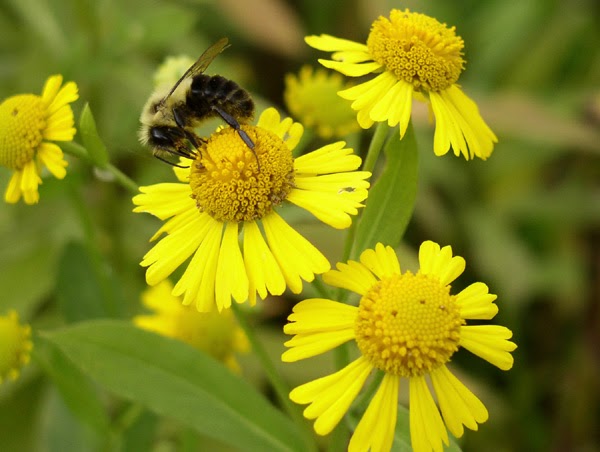 |
| Common milkweed. © Beatriz Moisset |
The herbivores are in turn eaten by other insects or
spiders, which may fall prey to still other carnivores. It is worthwhile to
examine one of these so called food chains or food webs.
 |
| Oleander aphids on common milkweed. © Beatriz Moisset |
 |
| Parasitized or mummified aphids. One wasp left the corpse through a round hole. © Beatriz Moisset |
This aphid has few enemies. One of them is a tiny parasitic
wasp. The mother wasp lays one egg inside a growing aphid and the larva
completes its entire life cycle inside the unfortunate host. By the end of the
aphid's life, it becomes dark, rounded and dried up. We call that a mummy. The
fully grown wasp cuts out a round hole and emerges ready to start parasitizing
other members of the aphid colony. It isn't easy to see the wasps, but almost
every aphid colony has some of these mummified bodies. So you know that the
parasitic wasps have been around.
 |
| Parasitic wasp. © Beatriz Moisset |
Lacewings, lady beetles and syrphid flies also feed on
aphids. Their stories are worth telling but we'll let them be for now.
The food web does not end there. Not surprisingly, many
predators visit the milkweed patch in search of animal food. Parasitic wasps
seem to be a delicacy among some flies. I have found members of two different
families of predatory flies dining on the wasps.
 |
| Robber fly (Taracticus octopunctatus) feeding on a parasitic wasp. © Beatriz Moisset |
One is a member of the family of robber flies, Asilidae. The
name describes the members of this family well. They are seen pouncing
mercilessly on their prey. One of them is Taracticus octopunctatus (no common name), a slender, hunchbacked fly with large eyes.
 |
| Long-legged fly feeding on a parasitic wasp. © Beatriz Moisset |
Another one is a longlegged fly, Condylostylus, a shiny metallic green fellow, with long skinny
legs. Parasitic wasps are part of its menu.
A second layer of predation is added to the one just
described. A spider feeds on a longlegged fly. We can summarize this food chain
this way:
I marvel about this food preference. Evidently, these flies
look down on the most abundant food nearby, the aphids, and go for the far less
common parasites. Perhaps, the latter have less cardenolides than the aphids
and this is why the predatory flies prefer them as food.
 |
| Longlegged fly caught by a spider. © Beatriz Moisset |
Milkweedaphidparasitic
wasppredatory flyspider
Will a bird sweep by and eat the spider? Will it in turn
fall prey to a hawk or a snake? How many steps can be added to this food chain?
Common milkweed feeds many members of the wild life directly and indirectly.
The links of this food chain are numerous.
More on milkweed dependents and visitors
More on milkweed dependents and visitors

















